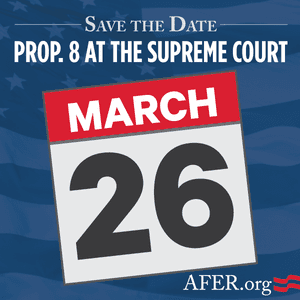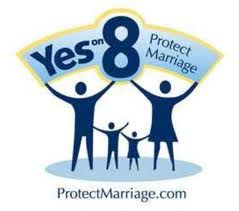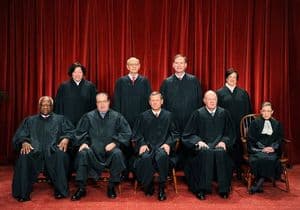 On Tuesday and Wednesday of next week, the Supreme Court will hear more than 3 hours of arguments in the challenges to the constitutionality of California's Proposition 8 (Hollingsworth v. Perry) and the Defense of Marriage Act (Windsor v. United States). In a series of short posts, I will preview and summarize the legal issues that will be raised. Today, standing in the Prop 8 case.
On Tuesday and Wednesday of next week, the Supreme Court will hear more than 3 hours of arguments in the challenges to the constitutionality of California's Proposition 8 (Hollingsworth v. Perry) and the Defense of Marriage Act (Windsor v. United States). In a series of short posts, I will preview and summarize the legal issues that will be raised. Today, standing in the Prop 8 case.
Standing is the first question the lawyers will argue and the first question the Court will answer. It has to be first because standing is what lawyers call a "jurisdictional" question: if a party doesn't have standing, it doesn't have the right to bring the case in the first place, so the court can't address the rest of the case.
So, what determines if a party has standing? Veterans of law school classes like Civil Procedure and Federal Courts will know that federal standing requires some type of "personal" or "direct injury." In other words, to bring a lawsuit to a district court, you have to be directly affected by the underlying incident giving rise to the case or, in the case of standing to appeal, you have to be directly (and adversely) affected by the lower court decision.
In the Prop 8 case, the standing question concerns the standing to appeal.
CONTINUED, AFTER THE JUMP…
 If you remember, when Hollingsworth got started, the law was initially defended by the state government. But, after Judge Vaughn Walker declared that bans on the freedom to marry violate equal protection and due process, neither then-Governor Schwarzenegger nor his successor, Governor Jerry Brown, had any desire to challenge that ruling. After the court thwarted a conservative California county's attempt to become party of the case after the fact, the only party left to defend Prop 8 was the group that wrote it: ProtectMarriage and ProtectMarriage.com. However, ProtectMarriage is just a small group of ordinary Californians who have no direct skin in the game other than the fact that they wrote and advocated for the law. The State of California is the party with a "direct injury": if Prop 8 dies, it has to change it's behavior and start issuing marriage licenses to gay couples. So, if California is the one "injured," how could a small group of people with no connection to the California government have standing?
If you remember, when Hollingsworth got started, the law was initially defended by the state government. But, after Judge Vaughn Walker declared that bans on the freedom to marry violate equal protection and due process, neither then-Governor Schwarzenegger nor his successor, Governor Jerry Brown, had any desire to challenge that ruling. After the court thwarted a conservative California county's attempt to become party of the case after the fact, the only party left to defend Prop 8 was the group that wrote it: ProtectMarriage and ProtectMarriage.com. However, ProtectMarriage is just a small group of ordinary Californians who have no direct skin in the game other than the fact that they wrote and advocated for the law. The State of California is the party with a "direct injury": if Prop 8 dies, it has to change it's behavior and start issuing marriage licenses to gay couples. So, if California is the one "injured," how could a small group of people with no connection to the California government have standing?
We spent most of 2011 waiting for the California Supreme Court, the highest court in the state and, therefore, the final arbiter on state law, to answer this conundrum for the Ninth Circuit: Does state law give initiative proponents standing to defend their proposal when the State declines to do so?
The California Supreme Court said yes, arguing that the power to "propose and enact" has no meaning without the power to "defend." And, because California has a liberal and expansive initiative proposal process, any other ruling would do violence to long-standing public policy of the state.
The Ninth Circuit pretty much accepted the California Supreme Court's ruling, arguing that ProtectMarriage did not, itself, have to show any direct injury: State law gave ProtectMarriage the power to step into the shoes of the State, piggy-backing on California's standing. All that was needed, then, for federal standing to appeal was California's standing — which was undisputed — and state law that allowed initiative proponents to assume the state's role when the state government declined to defend its own laws.
 This will be the first question the justices will address on Tuesday. And, they will start from the beginning. They don't have to agree with the Ninth Circuit. Nor do they have to even agree that the Ninth Circuit went about answering the question the correct way. The Court could say, along the lines of some discussion in a recent Supreme Court case called Arizonans for Official English v. Arizona, that regardless of what state law says, initiative proponents still have to show their own "direct injury." Notably, an amicus brief submitted by two former Republican Attorneys-General, John Ashcroft and Edwin Meese, argues that the Court could even ask the California Supreme Court about whether ProtectMarriage experienced "direct injury."
This will be the first question the justices will address on Tuesday. And, they will start from the beginning. They don't have to agree with the Ninth Circuit. Nor do they have to even agree that the Ninth Circuit went about answering the question the correct way. The Court could say, along the lines of some discussion in a recent Supreme Court case called Arizonans for Official English v. Arizona, that regardless of what state law says, initiative proponents still have to show their own "direct injury." Notably, an amicus brief submitted by two former Republican Attorneys-General, John Ashcroft and Edwin Meese, argues that the Court could even ask the California Supreme Court about whether ProtectMarriage experienced "direct injury."
That makes no sense. "Direct injury" is a question of federal law, and state courts have no role in answering purely federal questions. What's more, Arizonans suggests (though never explicitly decided) that the Ninth Circuit was wrong that initiative proponents need not demonstrate their own "direct injury." And, we cannot forget the political factors at play. Many experts think that the Court may use the jurisdictional question of standing to punt or narrow the scope of Hollingsworth. The Court may not be ready to decide the marriage question for the entire nation, or even for a small handful of states. Finding that ProtectMarriage lacked standing to appeal would erase the Ninth Circuit's opinion and leave Judge Walker's decision in tact and, thus, applicable only to the State of California. This would still be a victory for the freedom to marry because thousands of gay men and women in California could finally marry, ending their post-2008 nightmare.
But, the Court could just as easily agree with the Ninth Circuit or find federal standing on its own theory. If it does, the next step would be to address the merits of the case, which raises questions of the appropriate level of scrutiny, the justifications for Prop 8, and the reach of the Court's analysis. Stay tuned for a summary of these questions.
***
Ari Ezra Waldman teaches at Brooklyn Law School and is concurrently getting his PhD at Columbia University in New York City. He is a 2002 graduate of Harvard College and a 2005 graduate of Harvard Law School. His research focuses on technology, privacy, speech, and gay rights. Ari will be writing weekly posts on law and various LGBT issues. You can follow him on Twitter at @ariezrawaldman.



